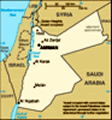Advertisement
Published: December 17th 2015
We drove to Wadi Musa, the town outside of Petra, after leaving Wadi Rum taking the Kings Highway. The Kings Highway was built over the ancient Nabataean trade route that connected Egypt with Damascus, Syria and the Euphrates River in Iraq. It has been used by the Romans for military conquests, for the medieval crusaders , and for Christian pilgrims still to this day. There are several desert crusader castles that dot the winding route through the Jordanian desert that we planned on visiting during our trip north.
After checking into our hotel, the Al Rashid ($50), we decided to check out some of the local sites around Petra. Wadi Musa "Valley of Moses" is the biblical site where it is said that Moses struck water from a rock for his followers and now is a small city that has sprung up around Petra to support tourism. It sits in the western Jordanian mountains at about 3,000ft and has spectacular views into the rose colored gorges below.
Our first day we went to Siq Al-Barid (Little Petra), a small canyon housing some caves and temples in the style of Petra. It is thought this area was
used as a trading and resupply post for the camel caravans visiting Petra. We climbed to the end of the siq (Arab gorge) up dozens of rock carved steps to a scenic overlook. Here we found an old Bedouin woman selling some jewelry and souvenirs. She was seated by a fire and asked us to join her for a cup of tea, and of course then I felt obligated to buy something from her. I ended up purchasing a beautiful handmade Bedouin necklace from her.
The next morning we arrived, shortly after opening, to Petra, or the "Rose City" because of the color of the rock. Petra is an ancient architectural masterpiece and is named one of the new 7 wonders of the world. The entire city was carved by the Nabataeans from the sandstone rock in the canyons in about 300 BC and at one time was the richest city in the world and served as the trading hub for the region for spices and incense.
Petra winds for miles through the gorge, covering 102 sq miles. It is recommended to take 2-3 days to properly see the entire area and we took a full day to
see the main highlights. Petra was officially rediscovered in 1812 by a Swiss explorer, but was not made into a famous tourist site until Indiana Jones and the Last Crusade. I remember learning of Petra from my father 20+ years ago when he became fascinated by it after learning of its existence from a Lebanese friend of his, and I too became fascinated by looking at the photos and knew one day I would have to visit.
We descended down the narrow Siq for about 1km in the cold and fog until we reached the famous Treasury. This facade is the most elaborate and popular one in the entire site, and where the majority of tourists stop on their visit for the day. The Treasury is hewn into the red sandstone with such precision it looks as though it was created in modern times. I found it to be stunningly beautiful and one of the most picturesque archaeological sites I have ever seen along with Machu Picchu.
Past the Treasury there are several other sites, such as a large amphitheater that could seat 6,000, more facades, countless tombs and sacrificial altars high on the cliffs. Petra's largest monument
,the Monastery, is few miles and over 900 steep steps past the Treasury. The Monastery was created in the same style as the Treasury, and is as beautiful and majestic as her sister, though not in the same stunning red sandstone but rather in a mild turmeric yellow. We had the Monastery area mostly to ourselves, and we shared the view and part of our lunch with a pack of 6 friendly feral cats that descended upon Dennis. We saved a pocket full of breakfast mystery meat for all the dogs and cats we befriended along the way, as is our tradition on all of our travels.
Just as we departed the Monastery to head back it began to rain, and proceeded to pour for most of our hike back. Luckily we had enough foresight to bring rain jackets to the desert, along with warm hats and gloves. As we doubled back through the areas we had seen in the morning we saw throngs of tourists, mostly Russians, packing all the areas we had to ourselves earlier in the day. We were told tourism was at 50% of what it was in Jordan previously and we were glad to
have seen it at a "low time" and couldn't imagine what it had to have been like in the busy seasons.
We wearily exited the site and enjoyed having several cups of tea and a steaming cup of Lentil soup to heat us up at a restaurant next to our hotel. Our waiter was a friendly Syria refugee who brought over a propane heater to warm us seeing that we were muddy, soaked and freezing. He told us he was soon being granted asylum to Canada, and asked us if the US was taking refugees and how to go about getting asylum there because that's where he really wanted to go because he "loved America."
Tomorrow we continue our journey north through this route of history along the King's Highway towards our final destination in Jordan, Madaba and the Dead Sea.
Advertisement
Tot: 0.123s; Tpl: 0.011s; cc: 19; qc: 75; dbt: 0.0709s; 1; m:domysql w:travelblog (10.17.0.13); sld: 1;
; mem: 1.2mb













D MJ Binkley
Dave and Merry Jo Binkley
Capturing the essence
Beautiful photos.